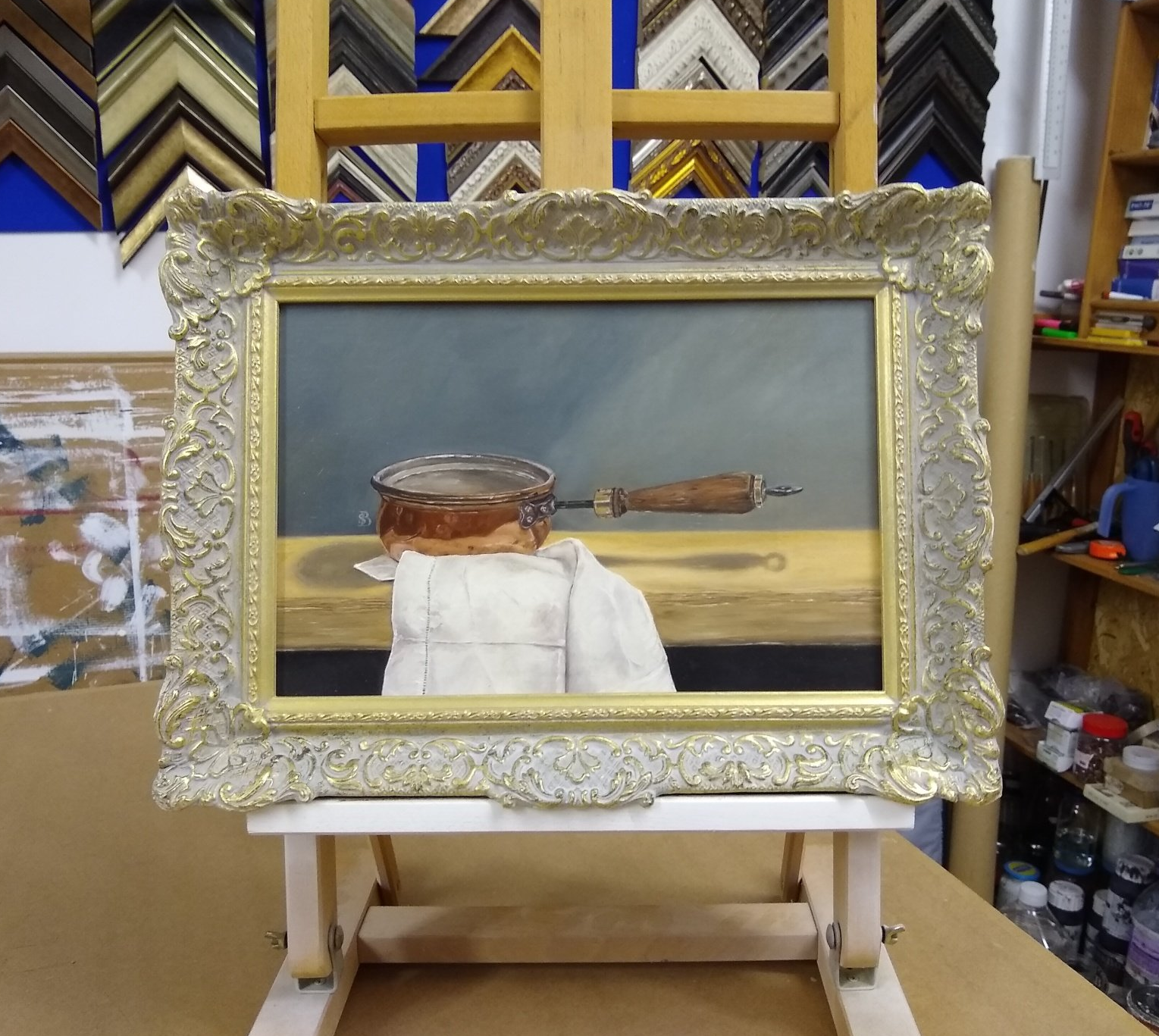Bespoke Picture Framing
Traditional and Contemporary Framing
We are only too pleased to offer advice on your picture framing requirements. With over 4000 moulding designs to meet both modern and traditional interiors as well as our extensive range of mountboard's which are all acid free. Our rigorous standards ensure that the finished frame will provide a safe and protective environment for your art work yet will be pleasing to the eye. Your frames can be hand painted to almost any colour including Farrow and Ball colours. Gold and Silver leaf is also available. We offer a full frame restoration and cleaning service as well as a full range of specialty glazing including acrylic. We recommend conservation UV glazing as a minimum.
- Full bespoke conservation picture framing service
- A comprehensive range of traditional and contemporary hand finished frames
- Mouldings from all leading UK suppliers
- Plain Wood Mouldings - Ash, Oak, Tulip, Maple, Cherry etc.
- Overmantels, Ovals, Mirrors & Spandrel frames made to order
- Bespoke mouldings designed and stained to meet your requirements
- Hand painted frames using Farrow & Ball Paints
- Hundred's of colour finishes
- Gilding in 9ct, 12ct, 16ct and 24ct gold and silver leaf available
- Speciality picture framing glass from Tru Vue and Artglass
- Restoration services - Click here
- Canvas and tapestries stretched
- Framing for exhibitions
- Acrylic Display Cases
- 2 - 6 week lead time depending on order
- If you can't see the service you require then please contact us.
Bespoke Handmade and Hand Finished Picture Frames
Picture Framing Glass
What is Anti Reflective glass?
When light passes from air into glass and then back into air, the transitions cause part of it to be reflected. A coating alters the light transmission qualities of glass surfaces, virtually eliminating reflections and maximising light transmission.
Invisible Glass
Conventional picture framing glass typically reflects 8% of incoming light, distracting the viewer with mirror-like reflections. With our picture glass, light reflection is as low as 0.5% thus offering 16 times less reflection and eliminating any mirror-like effects. Our provides 99% light transmission, making it practically invisible, so all the viewer observes is pure art.
True Colour Rendering
Neutral colours in reflection - other anti-reflective coatings tend to colour the reflective light, causing green, blue or red reflections that distract from the pure art viewing experience.
UV FILTRATION -Light is made up of differing wavelengths. For example a rainbow has different colours and each colour within the rainbow will have a different wavelength and each wavelength is measured in units, these are called nanometres. How large is a nanometre? 1 nanometre = 1 billionth of a meter (OR 1/80,000th of a human hair)
The most damaging light is UV (or Ultraviolet) invisible light between the 200 and 400 nanometre range, this range of light is invisible. Despite being invisible to the naked eye it is powerful enough to induce photo chemical damage to organic material such as paper or fabric, resulting in loss of colour, yellowing, bleaching, darkening and embitterment.
Ordinary Float glass filters around 54% of the harmful range, however this is NOT sufficient to offer any degree of protection. Whilst UV protection may not be an issue in certain circumstances where UV is not considered a hazard, there are still many instances where additional UV protection is still required.
The only truly effective way to protect valuable artwork is to block out UV light, which could be done through the control of light coming into the building (such as that undertaken by museums) or to simply lock it away in a darkened cupboard or control the light by fitting UV protection during framing.
Interestingly enough, the plastic that was used some years ago in the old red telephone boxes offered a very effective way to handle UV, this was a plastic called 'polycarbonate', the downside however was that it did this through 'absorption', which is why after a short period of time the plastic went white and could no longer be seen through.
The three most common ways to achieve UV protection are:
Conservation glass 99 UV - Coatings applied to the surface of the glass. This blocks 99% of UV light.
Laminates - in the majority of cases UV protection is achieved by using a UV filtering plastic interlayer (PVB). This provides higher UV protection than that of coatings and is invisible to the eye, furthermore laminates provide greater protection for artwork in the event the glass should be broken, which is why these are the product of choice for high end museums and galleries.
Plastics - Similar to laminates, the UV protection is generally impregnated within the plastic during production, increasing UV rating and viewing quality. These are ideal when images are to be transported or placed in public areas.
Artwork where protection from UV as a prime consideration
- Watercolours – UV light will literally kill the artwork.
- Old Photos & Posters – generally these are not colour fast and will fade quickly.
- Tapestries – where dyes are used to colour the threads, these will again fade when exposed.
- Organic substrates (such as textiles and paper) – UV light causes organic substrates to become brittle, rendering them beyond repair.
- Sentimental items – any artwork, image or item that is produced on paper or fabric that the customer deems to be of sentimental value should be protected. This includes 'little Johnnie's' first school painting!
Artwork where UV is not a consideration
- Oil Paintings – this due to the fact that the oils have UV protection within the base make up of the paint.
- Modern Photos/Prints – manufacturers are making progress within this area, producing light fast UV inks, and as such protection is not always required, however if you are in any doubt, add UV protection.

























